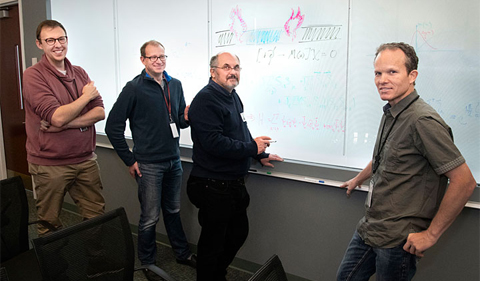
Theoretical calculations performed by (left to right) Neil Robinson, Robert Konik, Alexei Tsvelik, and Andreas Weichselbaum of Brookhaven Lab’s Condensed Matter Physics and Materials Science Department suggest that Majorana fermions exist in the boundaries of magnetic materials with different magnetic phases. Majorana fermions are particle-like excitations that emerge when single electrons fractionalize into two halves, and their unique properties are of interest for quantum applications.
The Ohio University NQPI Seminar Series presents OHIO alumnus Dr. Andreas Weichselbaum, on Thursday, Feb 13, at 4:10 p.m. in Clippinger Labs 194.
Weichselbaum is Associate Scientist of Brookhaven National Laboratory in New York. He earned a Ph.D. in Physics from the College of Arts & Sciences at Ohio University. His focus was in theoretical condensed matter physics, and his thesis title was “Nanoscale quantum dynamics and electrostatic coupling.”
Weichselbaum was named to the College of Arts & Sciences Notable Alumni Awards in 2019.
- See Notable Alumni | Andreas Weichselbaum Models Quasiparticles That Could Be Future of Quantum Computing.
- Connect with Weichselbaum on LinkedIn
Abstract: I will give a simple introduction to tensor network states with focus on fully exploiting general non-abelian symmetries. The underlying framework has been coded into a powerful tensor library dubbed QSpace [1] which has given rise to a range of excellent applications ever since. Here I will briefly highlight applications in 1D using the density matrix renormalization group (DMRG) [2, on the unified phase diagram of antiferromagnetic SU(N) spin ladders up to and including SU(6)], in 2D using projected entangled pair states (PEPS) [3, on simplex valence-bond crystal in the spin-1 Kagome Heisenberg antiferromagnet], and infinite-dimensions based on the dynamical mean-field theory (DMFT) [4, on Hundness vs. Mottness in metals].
[1] AW, Annals of Physics 327, 2972 (2012), arXiv:1910.13736 [cond-mat.str-el] (2019)
[2] AW et al., PRB 98, 085104 (2018)
[3] Liu et al., PRB 91 (R), 060403(R) (2015)
[4] Stadler et al. PRL 115, 136401 (2015), Annals of Physics 405, 365 (2019)



















Comments